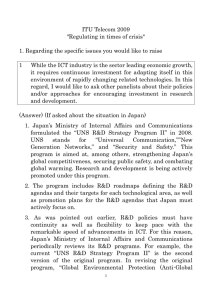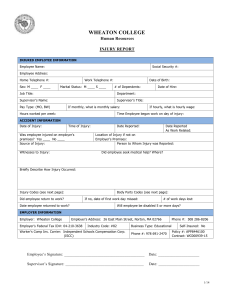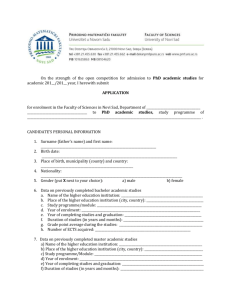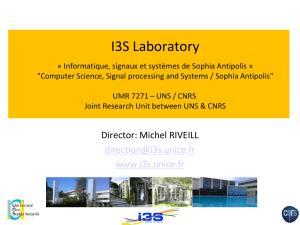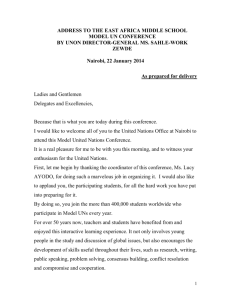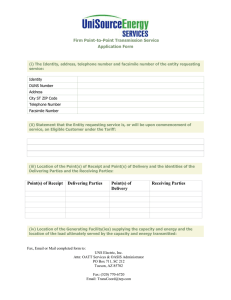Corrosion Resistance and Predicted Fitness for Use of Expandable
advertisement
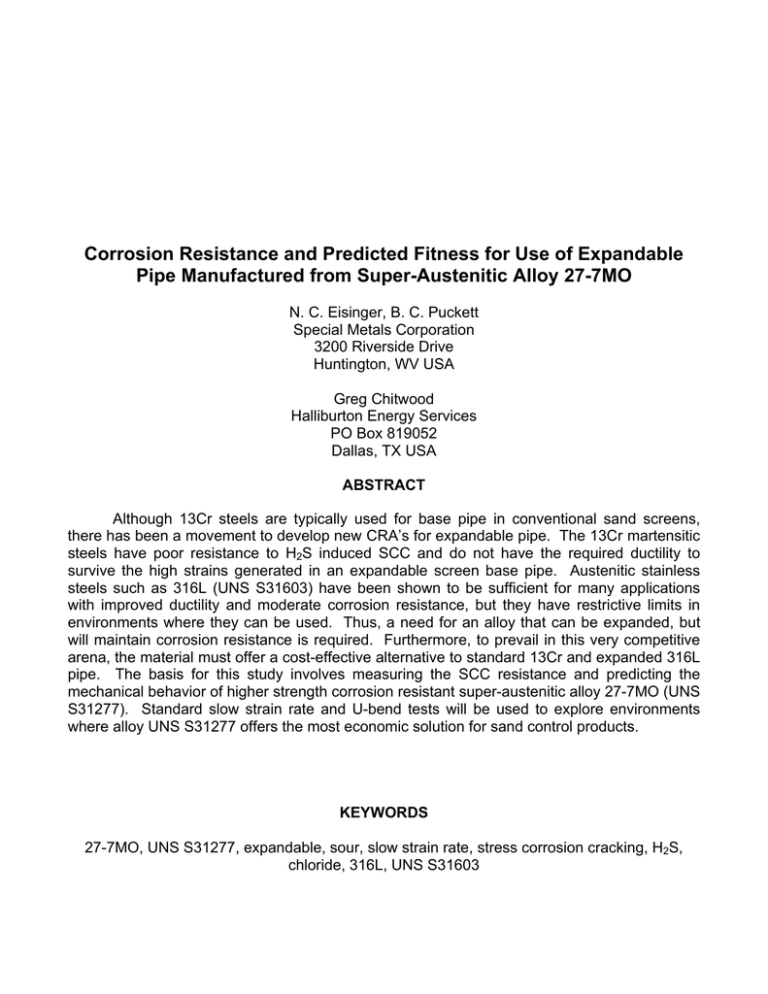
Corrosion Resistance and Predicted Fitness for Use of Expandable Pipe Manufactured from Super-Austenitic Alloy 27-7MO N. C. Eisinger, B. C. Puckett Special Metals Corporation 3200 Riverside Drive Huntington, WV USA Greg Chitwood Halliburton Energy Services PO Box 819052 Dallas, TX USA ABSTRACT Although 13Cr steels are typically used for base pipe in conventional sand screens, there has been a movement to develop new CRA’s for expandable pipe. The 13Cr martensitic steels have poor resistance to H2S induced SCC and do not have the required ductility to survive the high strains generated in an expandable screen base pipe. Austenitic stainless steels such as 316L (UNS S31603) have been shown to be sufficient for many applications with improved ductility and moderate corrosion resistance, but they have restrictive limits in environments where they can be used. Thus, a need for an alloy that can be expanded, but will maintain corrosion resistance is required. Furthermore, to prevail in this very competitive arena, the material must offer a cost-effective alternative to standard 13Cr and expanded 316L pipe. The basis for this study involves measuring the SCC resistance and predicting the mechanical behavior of higher strength corrosion resistant super-austenitic alloy 27-7MO (UNS S31277). Standard slow strain rate and U-bend tests will be used to explore environments where alloy UNS S31277 offers the most economic solution for sand control products. KEYWORDS 27-7MO, UNS S31277, expandable, sour, slow strain rate, stress corrosion cracking, H2S, chloride, 316L, UNS S31603 INTRODUCTION In sand control, the capability now exists for the sand screen to be expanded against the borehole ID, virtually eliminating the annulus around the screen and the need for gravel packing. While this provides the obvious advantage of larger production ID and ease of installation in horizontal applications, where gravel packing over long distances is problematic, this new method also has other benefits. The method increases the sand screen surface area, thus reducing pressure drop across the filter and increasing production rates. Finally, if a 'solid' expandable base pipe is used, because of its inherent high strength, the expanded screen can provide superior support to stabilize the borehole, which then minimizes the potential for sand production due to collapse and subsequent damage to the screen1. The challenge with the expandable screen base pipes has been that many conventional CRA materials, such as 13Cr, do not have sufficient ductility to undergo the more than 20% expansion required for this application. Mack has shown that the sulfide stress corrosion cracking resistance of 13Cr is poor following expansion of only 10%2. With this in mind, work has been done recently to characterize the corrosion performance of 316L (UNS S31603) for this application, since the austenitic stainless steels have ample ductility to survive expansion. UNS S31603 has been shown to work well in many sand control applications where the H2S content and temperature are low3. The testing involved developing an envelope of acceptability for temperature, chloride content, and H2S content that pushed the current limits established for UNS S31603 according to ISO15156/NACE MR0175. These limits are essentially a maximum temperature of 60 °C (140 °F) with a maximum H2S pressure of 15 psi (100 kPa) but no limit on chlorides; alternatively the H2S level can be higher with very low chloride limits. Using the SSR method, the practical upper limit for UNS S31603 would appear to be around 3 kPa (0.5 psi) H2S at salinity and temperature no more than about 50,000 ppm chloride and 93 °C (200 °F). This gives expandable UNS S31603 the ability to replace conventional 13Cr in many sand control applications. This replacement is feasible because sand control is often a problem in shallow reservoirs where temperature is naturally low. However, the 13Cr steel that UNS S31603 is to replace has a 10 kPa (1.5 psi) limit, but no temperature cap, so a large region exists that UNS S31603 could not fill. Recently, applications have been identified that demand a material for higher H2S, chloride, and/or temperature4. These data also suggests that S31603 is suitable for environments where very high levels of chlorides (up to 150,000 ppm) are present as long as oxygen is not present. This environment can indeed be present in non-sour wells where high chloride concentrations exist, but other work suggests that SSR tests may not find stress corrosion cracking in the absence of sour gas because the test duration is too short5. Thus, the seven to ten hour duration of the SSR test is not long enough to initiate and propagate SCC to a point where it drastically affects the results. In this research, U-bend tests established the limits of deaerated chloride solutions for both pitting and SCC to be strongly dependent on both temperature and chloride content. So, though SCC was not a factor in the seven hour SSR tensile test with 150,000 ppm of chloride, at 177 °C (350 °F), SCC was seen at much lower temperatures and concentrations of chlorides following a 13-day test. More recently, there has been an interest in using expandable screens for water injection service. Expandable screens are a good choice for this application if the screen mesh is a full-circumference, sintered media, rather than an overlapping leaf design; the former design is able to withstand pressure from the inside without failure. The larger ID of an expandable screen offers the opportunity to inject with lower pressure loss than conventional screens. Alternatively, the user can run larger diameter tools inside the screen, such as a zonal isolation tool to selectively inject into various intervals, without sacrificing tubing ID. At any rate, the water injection application is quite severe with regard to causing localized corrosion during the inevitable periods of lost oxygen control. It has been demonstrated by Evans et al. that UNS S31603 is susceptible to crevice corrosion under this condition6. The resistance to corrosion in this oxidizing environment is traditionally related to the Pitting Resistance Equivalence Number, or PREN, where a number of 40 or more is commonly thought to impart immunity. Using a commonly accepted PREN formula, PREN = Cr + 3.3(Mo + 0.5W) + 16N (1) the PREN of UNS S31603 is only about 23 as calculated from the composition shown in Table 1. This is too far below the requirement of 40. Clearly, there is a need for a material that will survive more hostile sour production environments as well as one that can be used in water injection. Alloy 27-7MO (UNS S31277) has been developed for situations such as these where standard stainless steels are not quite strong or corrosion resistant enough for an application, but where the jump to nickel-base alloys is not economical. The composition of UNS S31277 (Table 1) includes alloying elements for both solid solution strengthening and for corrosion resistance. Elements like chromium, molybdenum, and nitrogen are effective at increasing the corrosion resistance of the alloy to not only localized attack, but also general corrosion in many environments. The higher nickel helps prevent chloride stress corrosion cracking as well. Nitrogen and molybdenum also act as solid solution strengtheners when part of the matrix. Because of the low level of nitride formers in the alloy, the nitrogen remains in the solid solution and not in the form of nitrides or carbonitrides. Similarly, the alloy has been designed to maximize the PREN above over 50 without increasing the sigma solvus temperature, meaning that the molybdenum and chromium remain in solution and not as part of a deleterious secondary phase. UNS 31277 has seen use in several downhole environments where even typical 6% molybdenum stainless steels are not acceptable. Wireline applications, for example, use material cold drawn up to 75%. In these applications, both the strength and the corrosion resistance of UNS S31277 justify the use of the new alloy. For expandable tubes, the formability that limits the use of 13Cr steels is not an issue for UNS S31277 as the elongation to failure is greater than 40% even though the typical tensile strength is above 825 MPa (120 ksi) as noted in Table 2. Therefore, because UNS S31277 offers substantially better corrosion resistance and strength without any ductility loss compared with UNS S31603, interest has surfaced for its use in expandable tubing. This paper will show that UNS S31277 has excellent cracking resistance at much higher H2S content and temperature than UNS S31603 is capable of, while it maintains the mechanical characteristics needed for reliable expansion. Coupled with the ability to serve in water injection applications, UNS S31277 now gives operators the versatility to install expandable screens in extremely hostile applications. EXPERIMENTAL METHODS Slow Strain Rate Testing Several SSR tests as well as other corrosion tests were performed to test the idea that a more corrosion resistant stainless steel could satisfy a larger environmental envelope than UNS S31603 could due to chloride, oxygen, temperature, and/or H2S content. Table 3 shows industry limitations and new limitations found in previous work3,7. Based on the limitations, higher values of H2S, chloride content, and hardness were selected to test UNS S31277. Samples were taken from 12.7 mm (0.5”) plate and cold worked to achieve a predetermined hardness of either 27 or 35 Rockwell ‘C’ hardness (HRC). Cold working was performed on a hand mill with individual passes of 10% reduction or less. Initially, the hardness selected was equivalent to that of the UNS S31603 tested, but subsequent trials increased the hardness to 35 HRC or higher. Once cold worked to the desired hardness, material was machined to the standard SSR specimen described in NACE TM0198-20048. All material tested had triplicate environmental samples in addition to the inert test at 150 °C (302 °F). Samples were tested in the level V environment (detailed in NACE TM0198-2004) following proper deaeration procedures8. After nitrogen purging, the 15% solution of NaCl was charged with 700 kPa (101 psi) of H2S and 1.4 MPa (203 psi) of CO2. Test specimens were pulled with a constant strain rate of 4.0 x 10-6 sec–1 on a calibrated test frame. After testing, the gauge each sample was examined for secondary cracking, and, if the samples had less than 90% of the percent elongation, reduction of area, or time to failure of the inert test, the fracture surface was examined for ductility and evidence of SCC. Tensile Testing Supporting data such as room temperature tensile testing of material strained to 27% reduction of area via cold rolling was gathered from cold rolled plate in the previously millannealed condition. Cold rolling was accomplished on a hand mill with each rolling pass less than 10% reduction. Material was machined in the cold-worked condition and then tensile tested in accordance with ASTM E 89. Corrosion Testing Finally, ASTM G 48, methods C and D were used for comparisons between UNS S31603 and UNS S31277 to highlight the corrosion resistance of these alloys for use in water injection service10. Annealed material was ground to a 120-grit finish and then submerged in a 6% FeCl3 + 1% HCl solution for 72 hours. For crevice samples, a hole was drilled in the material and a PTFE slotted crevice device was torqued to 0.28 N-m (40 in-oz). The temperature was held constant through immersion of the flasks in a constant temperature water bath. The method used to gather seawater testing was reported previously as a 90-day exposure to natural seawater in Wrightsville Beach, NC 11. For the U-bend SCC samples, annealed material was cut into 127 mm (5”) x 25.4 mm (1”) x thickness strips and sanded to a 120-grit finish. U-bend samples were bent to a 2T bend and held in stress with UNS N10276 bolting. Prepared samples were immersed in either boiling 45% MgCl2 or a NaCl solution of varying concentration to test for resistance to chloride SCC (ClSCC) 12. RESULTS AND DISCUSSION The slow strain rate test results are compiled in Tables 3 and 4. All four heats of UNS S31277 tested demonstrated excellent ratios at the NACE level V environment. Table 3 compiles the results of triplicate environmental tests for four separate commercial heats. None of the tests from any evaluated heat had any secondary cracking but two individual tests showed a very small pit at the fracture surface. SEM examination confirmed a small amount of corrosion present on both of these samples although the ratios were still acceptable as the amount of affected material was negligible. The cause for this anomaly is unknown. Heat HW1129WR (Table 4) had lower than expected ratios on two of the tests leading to lower TTF and elongation ratios even though the RA numbers remained superb. The samples were closely examined for any corrosion attack or non-ductility but were free of any such defects. There was no hint of corrosion or SCC on either of the samples. One possible explanation for the ratios is a different machining technique used for half of the specimens. For this heat, the machinist changed his procedure after two samples and the remaining samples had noticeable machining grooves that were hand polished before testing. Perhaps this artifact led to premature failure. In any case, all four heats displayed acceptable SSR results at an environment that encompasses areas inaccessible to UNS S31603. Previous work has shown no detrimental effect of welding UNS S316033. Thus, no work was performed on welded UNS S31277, as autogenous welds would be solution annealed. Alternatively, if filler metal was used, the weld metal would be either alloy 686 (UNS N06686) or alloy 22 (UNS N06022), both of which provide much higher resistance to corrosion. In fact, both of these alloys are basically immune to SCC even in the presence of free sulfur up to 204 °C (400 °F) 8. As seen in Table 4, UNS S31277 is suitable for many environments where UNS S31603 does not have adequate corrosion resistance. Furthermore, the results of the tensile testing, shown in Table 2, demonstrate the large strength advantage of UNS S31277 over UNS S31603. Graphical presentation of these results is found in Figure 1 for the strength comparison and Figure 2 for elongation. The lower ductility found in the 27% cold worked UNS S31277 can be attributed to a steeper work hardening curve and the much higher strength compared with UNS S31603. For water injection systems, pitting and crevice corrosion resistance of candidate materials is of utmost importance. Standard tests such as ASTM G 48 methods C and D quantify this resistance by determining the critical pitting (CPT) or critical crevice corrosion temperature (CCT) in an oxidizing media. These temperatures represent the lowest temperature at which an alloy will undergo pitting or crevice attack in a given environment. The results of these tests allow engineers to rank competitive alloys. The PREN, discussed previously, will often predict results in this type of testing too. See Table 5 for results of pitting and crevice testing of UNS S31603 and UNS S31277. As predicted by the large difference in PREN between UNS S31277 and UNS S31603, UNS S31277 has dramatically better localized corrosion resistance with a CPT 65 °C (150 °F) higher and a CCT 45 °C (113 °F) above that of UNS S31603. UNS S31277 also outperformed UNS S31603 in standard ClSCC tests in both boiling magnesium chloride and sodium chloride solutions as seen in Tables 6 and 7 respectively. It is common knowledge that UNS S31603 will fail rapidly in boiling MgCl2, but other work has shown that UNS S31603 can exhibit SCC in boiling NaCl solutions containing 500 ppm chloride after 13 days. The UNS S31277 was unaffected by any boiling NaCl solution after a month. The higher nickel level of the UNS S31277 accounts for much of this performance in both chloride solutions. The higher PREN also prevents pitting, which can initiate SCC. When seawater injection is used, seawater corrosion resistance is also important. Previous studies have shown UNS S31277 has seawater resistance of a nickel-base alloy such as alloy 625 (UNS N06625) while UNS S31603, as well as other 6% Mo alloys are subject to localized corrosion at ambient temperatures11. After 90 days, UNS S31603 was penetrated to a depth of 3 mm (0.12”) in ambient seawater while UNS S31277 was unaffected even in the region covered by a crevice washer. Future work to fabricate and test perforated tubing in a bend test is also underway to prove the capabilities of the alloy in actual simulated well conditions, but current data show the capability of UNS S31277 to perform in harsh environments where UNS S31603 does not have adequate corrosion resistance. CONCLUSIONS 1. The results of the current test program show that INCOLOY® alloy 27-7MO (UNS S31277) is acceptable for NACE MR0175 / ISO 15156 at the Level V environment. 2. UNS S31277 has resistance to SCC at much higher levels of H2S, temperature, and chloride content than UNS S31603. 3. UNS S31277, with elongation at failure greater than 40%, has sufficient ductility for expanded pipe applications. 4. UNS S31277 can be used in sand control or other applications where UNS S31603 does not offer enough SCC or pitting resistance. It also possesses more than sufficient corrosion resistance to replace 13Cr material. 5. UNS S31277 has dramatically better SCC, pitting, seawater, and crevice corrosion resistance than UNS S31603 without the up-front cost of a higher nickel-base alloy. ® INCOLOY is a trademark of the Special Metals group of companies REFERENCES 1. Echols, R., Gano, J., Shy, P., Tuckness, C., Zhang, H., and Campo, D., “Development and Testing of a Viable Alternative to Horizontal Gravel Packing: An Expandable Sand Screen and Expansion Tool”, Paper OTC 14219, 2002 Offshore Technology Conference, Houston, Texas U.S.A., 6–9 May (2002). 2. Mack, R. “Evaluation of Selected Martensitic Stainless Steels for Use in Downhole Tubular Expansion – Results of a Laboratory Study”, paper no. 263 Eurocorr 2004, Nice, France (2004). 3. Chitwood, G., Skogsberg, L., "The SCC Resistance of 316L Expandable Pipe in Production Environments Containing H2S and Chloride”, paper number 04138, Corrosion/2004, New Orleans, NACE International, Houston, TX, (2004). 4. Chitwood, G., Skogsberg, L., "Cost-Effective Solutions for Corrosion-Resistant Expandable-Screen Base Pipe in Sour/Brine Service”, Paper 2004-185, presented at the Canadian International Petroleum Conference held in Calgary, Alberta, Canada, June 8 – 10, (2004). 5. Oberndorfer, M, Thayer, K, Kastenbauer, M., “Application Limits of Stainless Steels in the Petroleum Industry”, Materials and Corrosion, Vol. 55, No 3 p 174-180 (2004). 6. Evans, T.N., Nice, P.I., Schofield, M.J., and Waterton, K.C., "Corrosion Behaviour of Carbon Steel, Low Alloy Steel and CRA’s in Partially Deaerated Seawater and Comingled Produced Water", paper number 04139, Corrosion/2004, New Orleans, NACE International, Houston, TX, (2004). 7. NACE Standard TM0198-04: “Slow Strain Rate Test Method for Screening CorrosionResistant Alloys (CRA’s) for Stress Corrosion Cracking in Sour Oilfield Service”, NACE International, Houston, TX., (2004). 8. NACE MR0175 / ISO 15156: “Petroleum and Natural Gas Industries – Materials for Use in H2S-Containing Environments in Oil and Gas Production”, NACE International, Houston, TX (2003). 9. ASTM E 8-01: “Standard Test Methods for Tension Testing of Metallic Materials”, ASTM, W. Conshohocken, PA., (2001). 10. ASTM G 48-03: “Standard Test Methods for Pitting and Crevice Corrosion Resistance of Stainless Steels and Related Alloys by Use of Ferric Chloride Solution”, ASTM, W. Conshohocken, PA., (2003). 11. Eisinger, N.C., Crum, J.R., Shoemaker, L.E., ”An Enhanced Superaustenitic Stainless Steel Offers Resistance to Aggressive Media”, paper 03256, Corrosion/2003, San Diego, NACE International, Houston, TX, (2003). 12. Eisinger, N.C., Crum, J.R., Puckett, B.C., “Development of 27-7MO: an Improved Superaustenitic Stainless Steel with High Strength and Excellent Corrosion Resistance for Sour Service”, paper number 04114, Corrosion/2004 New Orleans, NACE International, Houston, TX, (2004). Table 1: Typical Chemical Composition of Materials Discussed (wt%) Alloy C Fe Cr Ni Mo N Cu 13Cr 0.20 Bal 12.75 0.1 UNS S31603 0.02 Bal 16.8 10.3 2.4 0.03 0.3 UNS S31277 0.01 Bal 22 27 7.25 0.35 0.75 Mn 0.5 1.7 1.3 Table 2: Room Temperature Mechanical Properties of Materials Tested Alloy Cold Hardness Tensile Strength Yield Strength Elongation Reduction (UNS) HRC (Rb) MPa (ksi) MPa (ksi) % S31277 0% (95) 820 (119) 440 (64) 50 S31603 0% (88) 600 (88) 338 (49) 44 27% 36.3 1182 (171.5) 1008 (146.4) 15.2 S31277 27% 37.4 1195 (173.2) 1060 (153.7) 15 27% 30.8 881 (127.7) 792 (114.8) 19.1 S31603 27% 29.2 872 (126.5) 759 (110.0) 19.4 Table 3: Acceptable(8) and developed(3) SSRT limits for materials discussed Alloy Temperature Chloride H2S Hardness (8) 13-Cr Any in Production 10 kPa 22 HRC UNS S31603(3) 107 °C 10,000 ppm 3 kPa 29 HRC (3) UNS S31603 79 °C 50,000 ppm 3 kPa 29 HRC UNS S31603(3) 93 °C 50,000 ppm 1 kPa 29 HRC (8) UNS S31603 60°C Any in Prod 100 kPa 22 HRC UNS S31277 150 °C 150,000 ppm 700 kPa 36 HRC Table 4: SSR Test data for several heats of UNS S31277 Evaluated in 15% NaCl + 0.7 MPa (101 psia) H2S + 1.4 MPa (203 psia) CO2 Test Temperature of 150 °C (302 °F) (Level V) Material Hardness TTF ratio RA ratio Elong. ratio Secondary Cracking Heat Number on any sample? HRC % % % HW1106WR 27 90.9 100.5 90.2 None HW1129WR 36.5 90.0 102.0 89.2 None Y9566 37 104.9 94.4 109.7 None HW1100WR 36 98.5 93.2 97.4 None *Note: all results are the average of three environmental tests Table 5: Critical pitting and crevice temperatures of S31603 and S31277 Alloy CPT (°C) CCT (°C) PREN UNS S31277 > 85 45 51.5 UNS S31603 20 <0 25.2 Table 6: SCC resistance of UNS S31277 Examination of stressed U-Bend samples in several NaCl concentrations at boiling for 1,500 hours NaCl % UNS S31277 2 No cracking 10 No cracking 20 No cracking 26 No cracking Also note UNS S31603 has been shown to have SCC in boiling solutions of NaCl after 315 hours and 500 ppm Cl- 7 Table 7 A Comparison of UNS S31277 and UNS S31603 for Resistance to Stress Corrosion Cracking, Duplicate Samples. Environment: Boiling 45% Magnesium Chloride. Time to Crack Time to Fail Alloy (Hrs.) (Hrs.) <24 <288 UNS S31277 27-7MO <24 <288 <6 <6 UNS S31603 316L SS <6 <6 Figure 1 Mechanical Property Comparison of UNS S31603 and UNS S31277 175 1200 1000 Strength (MPa) ksi 800 85 600 400 30 200 0 Yield Strength (Mill Annealed) Yield Strength Tensile Strength Tensile Strength (27% Cold Work) (Mill Annealed) (27% Cold Work) UNS S31277 UNS S31603 Figure 2 Comparison of Ductility between UNS S31603 and UNS S31277 50 Elongation at failure (%) 45 40 35 30 25 20 15 10 5 0 Elongation (Mill Annealed) UNS S31277 Elongation (Cold Worked 27%) UNS S31603
